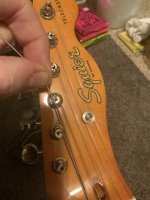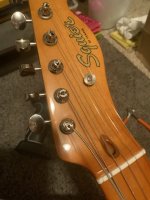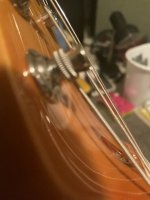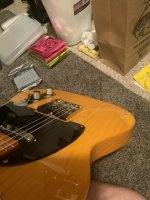3bolt79
Moderator
- Joined
- Jun 28, 2024
- Messages
- 762
- Reaction score
- 1,485
Setting up a Telecaster is in some ways similar to setting up a Strat, but it is also somewhat different. See the threads “Setting up your first strat, 1,2, and 3 for general information.
Step 1
Get the neck relief set. I like to remove the strings and get the neck as straight as possible with Either a Notched straight edge on the board, but if you don’t have one, getting the first fret to the end of whatever straight edge you have, with all the frets touching the straight edge is a good place to start. The relief will add itself when the strings are installed.
When installing strings on a telecaster, or other Fender guitar with the open top slotted tuners, pull the string taught and cut between two to three pegs distance from the one you are installing the string on. See pic.

Cut the string and insert it in the hole and bend the string at the end of the slot.


Now wind the string. You should have 2 to 3 wraps around the peg when done winding. See pic.

You will want 5 wraps on the plain steel strings so you will have to cut the strings about the distance of 5 tuning pegs from the tuner you are installing the string on.
After Stringing, you may need to tighten or loosen the trus rod a wee bit if you feel that your neck has too little or too much relief. You should be able to put a capo on the first fret and depress the 17th fret on the Low E string and be able to barely slip a business card under the 6th fret.
Step 2
Set or action, IE the string height at the 17th fret across all strings. Fender spec is 4/54ths for the High E, B, G and D strings and 5/64ths for the A and Low E strings, + or - 1/64th.
As most Telecasters have three barrel saddles with two strings on each of the,, you will need to tilt the saddles one way or the other to get your desired string height and to follow the radius of the fretboard.

STEP 3
Adjust your intonation. With two strings per saddle, you will want to compare the open string note to the 12 fret, fretted note. You will want to adjust the intonation based on the thicker of the two strings on the saddle. If it’s sharp at the 12th fret, move the saddle toward the strap button on the butt of the guitar. If it’s flat, move the saddle toward the nut. Retune and repeat until the thicker string is a perfect octave above the open string at the 12th fret.
By adjusting the thicker string, the thinner string will usually fall where it needs to be. Do this for all three saddles and then play your cowboy chords. It they sound good, you are done for now.
Step 4
Check to see if the tuned open string will play in tune at the first fret. If it’s sharp, you have either a little too much relief in the neck, or the nut’s slot is too high. If the first fret note is sharp, tighten the truss rod an 8th of a turn and retune and recheck the first fret note. If that doesn’t fix it, see a tech and have him lower the nuts slots where necessary. Then recheck the intonation using the thicker of the strings on each saddle, and adjust as needed.
You should be able to play the F Maj barre chord at the first fret easily and in tune. If the nut’s slots are too high you will have to press harder and the notes won’t be in tune.
Note, if you have a finished fretboard and it is dirty, a little winded on a per towel will work well to clean the fretboard. Wipe it on and wipe it off. It won’t hurt the plastic finish on the above shown Squier. Don’t do this with a lacquer finished fretboard though, or on an unfinished wood fretboard. Instead wipe with a cloth slightly damped with water for a lacquer finished board. For a bare wood board like rose wood, use fretboard oil.
Thanks to @Strummer for letting me use pics of his guitar for this thread.
Step 1
Get the neck relief set. I like to remove the strings and get the neck as straight as possible with Either a Notched straight edge on the board, but if you don’t have one, getting the first fret to the end of whatever straight edge you have, with all the frets touching the straight edge is a good place to start. The relief will add itself when the strings are installed.
When installing strings on a telecaster, or other Fender guitar with the open top slotted tuners, pull the string taught and cut between two to three pegs distance from the one you are installing the string on. See pic.

Cut the string and insert it in the hole and bend the string at the end of the slot.


Now wind the string. You should have 2 to 3 wraps around the peg when done winding. See pic.

You will want 5 wraps on the plain steel strings so you will have to cut the strings about the distance of 5 tuning pegs from the tuner you are installing the string on.
After Stringing, you may need to tighten or loosen the trus rod a wee bit if you feel that your neck has too little or too much relief. You should be able to put a capo on the first fret and depress the 17th fret on the Low E string and be able to barely slip a business card under the 6th fret.
Step 2
Set or action, IE the string height at the 17th fret across all strings. Fender spec is 4/54ths for the High E, B, G and D strings and 5/64ths for the A and Low E strings, + or - 1/64th.
As most Telecasters have three barrel saddles with two strings on each of the,, you will need to tilt the saddles one way or the other to get your desired string height and to follow the radius of the fretboard.

STEP 3
Adjust your intonation. With two strings per saddle, you will want to compare the open string note to the 12 fret, fretted note. You will want to adjust the intonation based on the thicker of the two strings on the saddle. If it’s sharp at the 12th fret, move the saddle toward the strap button on the butt of the guitar. If it’s flat, move the saddle toward the nut. Retune and repeat until the thicker string is a perfect octave above the open string at the 12th fret.
By adjusting the thicker string, the thinner string will usually fall where it needs to be. Do this for all three saddles and then play your cowboy chords. It they sound good, you are done for now.
Step 4
Check to see if the tuned open string will play in tune at the first fret. If it’s sharp, you have either a little too much relief in the neck, or the nut’s slot is too high. If the first fret note is sharp, tighten the truss rod an 8th of a turn and retune and recheck the first fret note. If that doesn’t fix it, see a tech and have him lower the nuts slots where necessary. Then recheck the intonation using the thicker of the strings on each saddle, and adjust as needed.
You should be able to play the F Maj barre chord at the first fret easily and in tune. If the nut’s slots are too high you will have to press harder and the notes won’t be in tune.
Note, if you have a finished fretboard and it is dirty, a little winded on a per towel will work well to clean the fretboard. Wipe it on and wipe it off. It won’t hurt the plastic finish on the above shown Squier. Don’t do this with a lacquer finished fretboard though, or on an unfinished wood fretboard. Instead wipe with a cloth slightly damped with water for a lacquer finished board. For a bare wood board like rose wood, use fretboard oil.
Thanks to @Strummer for letting me use pics of his guitar for this thread.
Last edited: